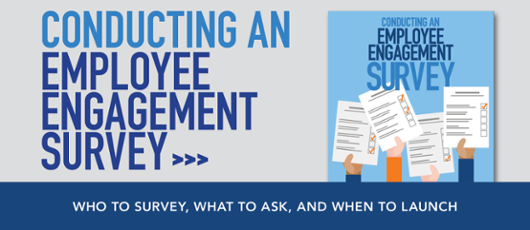How to Communicate Employee Engagement Survey Results
 You’ve surveyed your employees and the results are in. Now what?
You’ve surveyed your employees and the results are in. Now what?
The first step after an employee engagement survey is communicating the results to your employees. This is one of the most important steps of the survey process.
Communicate well and you can inspire participation and buy-in for your engagement initiatives. Communicate poorly and you may lose the trust of your employees, and even cause disengagement. With such high stakes, it’s important to plan your communication carefully.
Use the following tips on how to communicate employee engagement survey results effectively in both company-wide and manager-to-team settings.
1. Thank employees for participating.
Who: From senior leadership and HR to all employees.
What: The first thing you should do when a employee survey closes is send out a company-wide email from top leadership thanking employees for their participation.
Your email should:
- Confirm the survey close
- Thank employees for participating
- Outline next steps in the process
The email should include a personalized thank you as well as a brief roadmap outlining next steps. This shows your employees that you appreciate their time and value their feedback. Just remember to follow through on the expectations you set in this email, otherwise, you risk losing credibility and trust.
| Pro Tip: Encourage your team leads and managers to follow up with a verbal thank you in their team meetings after the survey closes as well. This reinforces your message and helps your employees feel appreciated on a more personal level. |
When: Immediately following the survey close.
Why: This step is simple but important. Following up right away and clarifying your plans assures employees of your commitment to act on their feedback.
2. Provide an initial overview of results.
Who: From senior leadership to all employees.
What: Best practice is to share your employee engagement survey results in phases, starting with high-level results and then filtering results down to individual teams for a closer look. You can present the results in a company-wide email or in a town hall meeting.
Whatever format you choose, your review should include details like:
- Participation stats
- Top and bottom survey results
- Plan of action
Keep the focus on broad organizational trends. This isn’t the time to dig into team-specific results or applications. Instead, highlight results that apply to employees company-wide, making sure to include both positive results as well as negative ones.
Glossing over organizational weaknesses can cost you credibility and respect from your employees. Plus, negative feedback is an important part of identifying key opportunities for improvement. Including both perspectives will ensure your employees feel heard and that you recognize weaknesses and intend to take concrete action on them.
When: Start with a high-level overview of the survey results within one week of the survey close.
Why: Sharing results with employees as soon as possible keeps the feedback top-of-mind for employees and helps them connect the results and action plan to their comments.
3. Analyze results with leadership.
Who: Senior leadership and HR.
What: Meet with company leaders to go over your survey results in greater detail. This meeting is an opportunity for leaders to discuss survey results and get consensus on next steps before moving forward. This is best done in a presentation format that encourages open dialogue.
Present key details such as the overall engagement score, organizational vs. departmental trends, strengths, weaknesses, and opportunities. Then, work together to outline your employee engagement action plan, including what your targeted initiatives will be and your focus group assignments.
Focus groups are an important part of your communication efforts, because they will be able to dig into the survey results in greater depth and identify key takeaways.
When: 3 weeks after the survey closes.
Why: Leadership needs to be on the same page before moving forward with any action items following your survey. Planning out next steps and assigning focus groups ensures you are aligned in your ongoing engagement efforts.
4. Announce detailed results.
Who: From senior leadership to all employees.
What: Once your company and team leaders have reviewed results in more depth, you can present more detailed survey results and takeaways.
Be sure to include:
- Intended areas of focus
- Actions already taken
- Future follow up plans
Although you should provide a detailed breakdown of results, you don’t need to include everything. You will be working with a lot of data from the survey. Highlight the most important takeaways and focus areas.
When: 1-2 months after the survey closes.
Why: Your detailed survey results email is a crucial part of your communication. This is an opportunity to demonstrate exactly what the results were and how you are acting on them. When you can communicate those two things effectively, employees will feel valued, listened to, and more inclined to participate in future surveys.
5. Discuss team-level results within teams.
Who: Managers and their teams.
What: Discuss survey results at the team level with employees across the organization.
- Keep it simple.
When discussing the results, focus on the most and least favorable responses. These represent the team’s strengths and opportunities and serve as a perfect introduction to discussing areas of improvement. - Initiate dialogue by asking open-ended questions.
Start with thought-provoking questions like, "what was on your mind when answering this question?" or "what can the team do to help you strongly agree with this question?" These questions will invite honest conversations that build the foundation of how to improve in the future. To take this step even further, consider conducting an employee focus group to facilitate meaningful follow-up conversations after the initial meeting. - Align on next steps.
Clearly define what is being improved and how. Include information on who is leading the change, what are the first steps, and end goals. This implementation roadmap shows dedication to the betterment of the team—whether that’s employee engagement, experience, or performance. Collaborating also reiterates the importance of shared responsibility on a team and individual ownership of employee engagement.
When: 2 months after the survey or once detailed results have been announced.
Why: Overall organizational trends are important, but the real value is found at the local level where the insights and takeaways apply specifically to them. The goal of these team meetings and focus groups is to share team results within the context of the broader company trends and work together to identify areas for improvement and a plan of action.
Communication Tips for Sharing Employee Engagement Survey Results
When sharing employee engagement survey results in company-wide and team messaging, keep the following best practices in mind.
Be open.
Being open and honest is critical to communicating employee survey results. Don’t try to position results to be better or worse than they are. Talk openly about the results. How you talk about survey results sets the tone for receiving continued honest employee feedback and their ideas for improvement. Being open builds trust.
Be clear.
Employee survey results can be difficult to understand. Be as clear and concise as possible when you share the results with employees. Avoid jargon and commentary that will create confusion.
Respect employees’ responses.
Don’t guilt-trip your employees. Employees should never feel like they have to retract their survey responses. If you make them feel guilty about your organization’s survey results, they are less likely to trust you and the survey process.
Don’t debate who’s right and who’s wrong.
Employee survey follow-up conversations aren’t about debating which opinions are superior. Employee surveys reveal employee perceptions, and right or wrong, perception is reality. Debating right versus wrong sends the message that not all employees’ feelings and experiences are considered valid and that disengages.
Ask for questions.
Always ask for questions. If you’re presenting the survey results during an employee focus group, ask for questions after each data slide. If employees seem quiet, let them know you’ll be asking direct questions during the discussion.
Don’t play “who said what.”
Employee engagement survey responses should be confidential. When reviewing employee survey results, the conversation should never turn into speculations about who said what. This diminishes the credibility and integrity of a confidential survey process.
Be objective.
When communicating survey results, do your best to play the role of an impartial observer. Communicate the findings without interspersing personal opinions. If you are conducting an employee focus group, your personal opinions could sway employee opinion and steer the discussion off course. In addition, employees might be unlikely to share opinions if they’re dissenting from the perceived group leader.
Communication can make or break your engagement efforts. Keep everyone on board and demonstrate your ongoing commitment to your employees by communicating survey results clearly, honestly, and in a timely manner.
Whether it’s an employee engagement survey, a pulse survey, or anything in between, follow these tips and framework in our ebook—Conducting an Employee Engagement Survey—to make the results-sharing conversation easier and more effective at every level.







